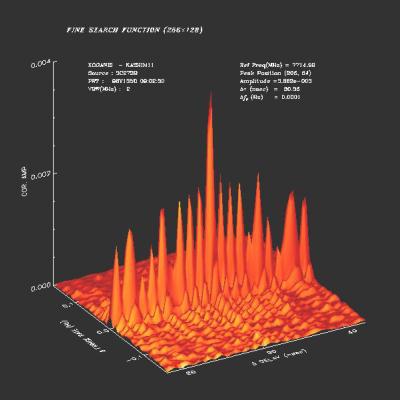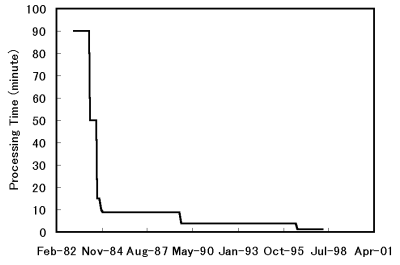
Figure 1. An example of a fine delay resolution function. KOMB was named after its "comb" like structure which is seen in the delay domain.
Kashima Space Research Center
Communications Research Laboratory
893-1 Hirai, Kashima, Ibaraki 314-0012, Japan
A bandwidth synthesizing software can calculate residual delays with a time resolution of more than 0.1 nsec from raw correlator output data by synthesizing multichannel correlation data. This software is called KOMB in the VLBI system developed by CRL. We describe in this report KOMB's background and focus on its improvement in the processing speed.
In a geodetic VLBI observation, it is important to measure the difference between arrival times of radio signals from a common source (quasar) at two stations, which is simply referred to as the delay time. Time resolution is approximately the order of the reciprocal of the frequency bandwidth. Although we can record a limited amount of the frequency bandwidth signals on the magnetic tape,a wide bandwidth is needed to accurately observe delay time. Bandwidth synthesizing was therefore developed to increase the apparent bandwidth by combining a number of narrow bandwidth data. Phase calibration (PCAL) signals are injected in the input of a low-noise amplifier in order to synthesize the different frequency channel data coherently. KOMB first subtracts the instrumental phase difference of each channel from fringe phases by using PCAL phases. Then it calculates the fine delay resolution function, which is defined as a function of the trial delay and the delay rates. We will not include the detailed mathematical explanation of this data processing because it is not the purpose of this short report, but we will show an example of a fine delay resolution function calculated for actual VLBI data which was observed at 8 GHz on the Keystone Project network (Figure 1). KOMB was named after the shape of the fine delay resolution function which looks like a "comb".

KOMB was developed in 1983 on an HP1000/45F minicomputer in order to process the K-3 correlator output data which consists of 14-channel 8-bit-lag complex correlation data. Initially it took more than one hour to process a single observation data of six minutes. But by the end of 1984, the processing time improved to nine minutes for a six-minute observation. And 1989, it took only four minutes. This drastic speed-up in processing time was achieved by merely porting the software to an HP1000/A900 minicomputer.
In 1996, the software was ported to an HP9000/735 workstation and was modified to handle KSP's correlator output which is a 16-channel 32-bit-lag complex correlation data. By porting KOMB into this powerful workstation, the processing time significantly improved. It now takes less than 1 minute for a six-minute observation data. The improvement in processing time is summarized in Figure 2.

A workstation version of KOMB is being used at the Geographical Survey Institute
to process their domestic VLBI observation data.